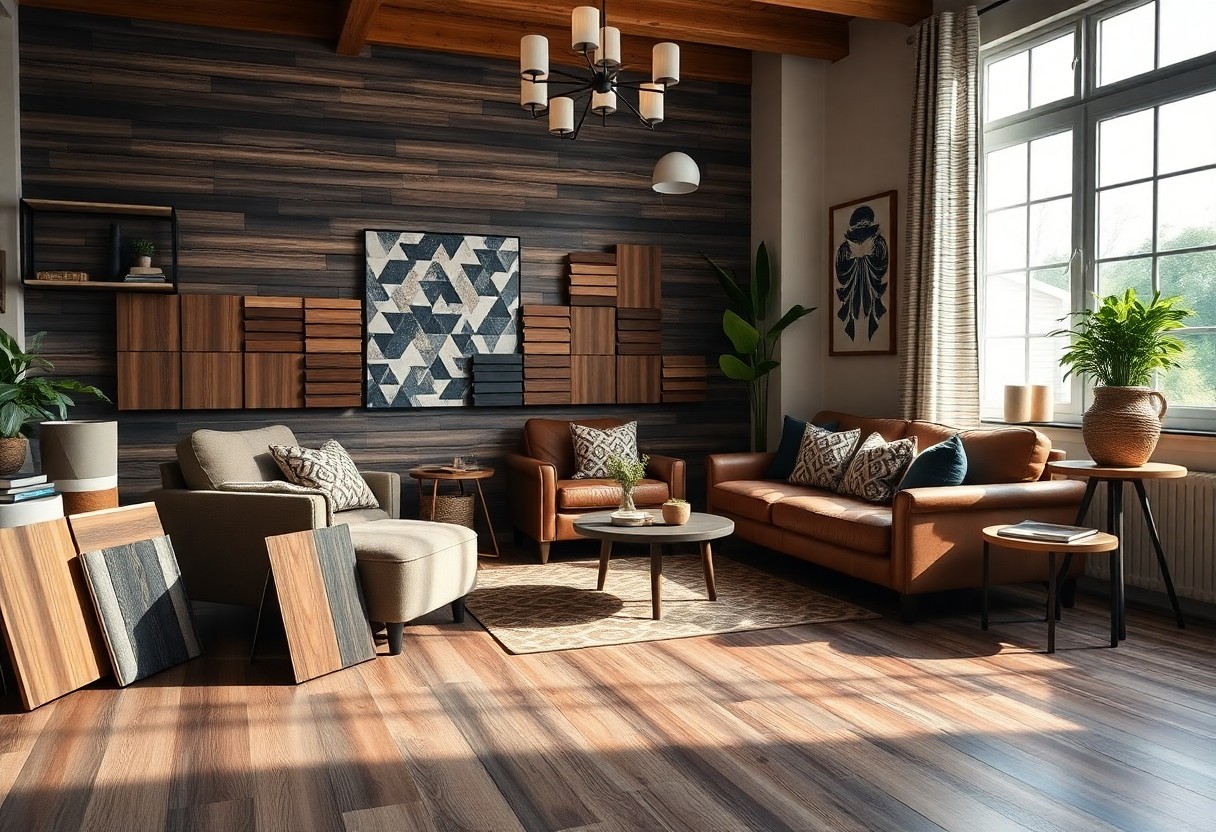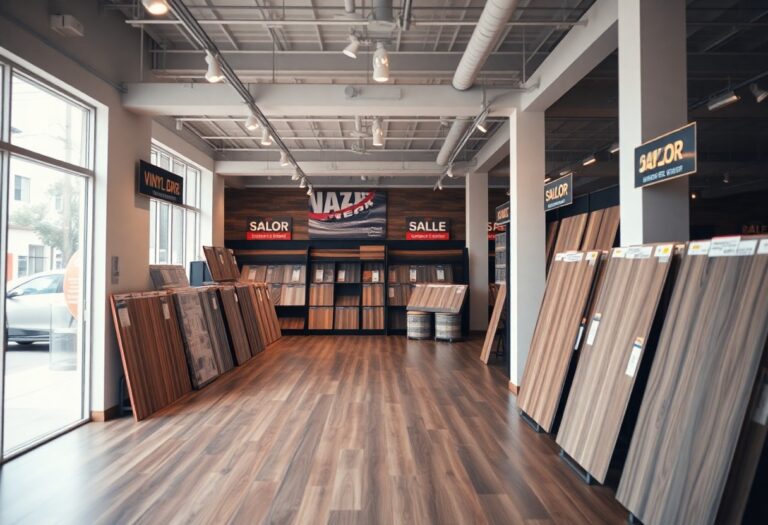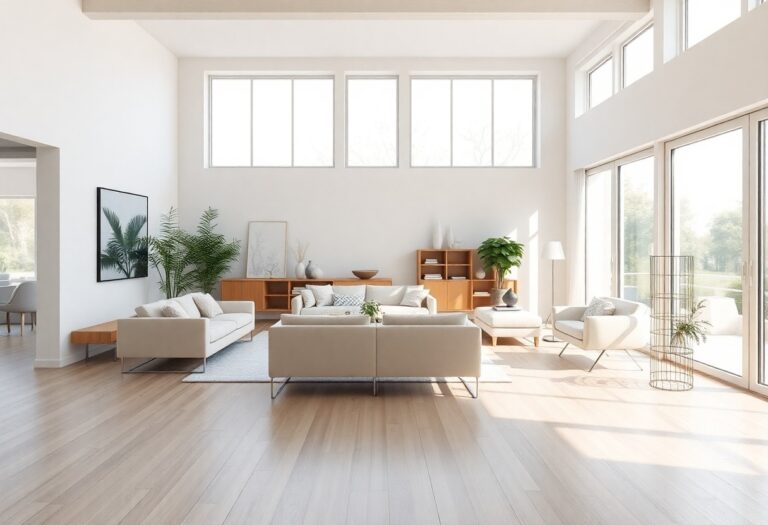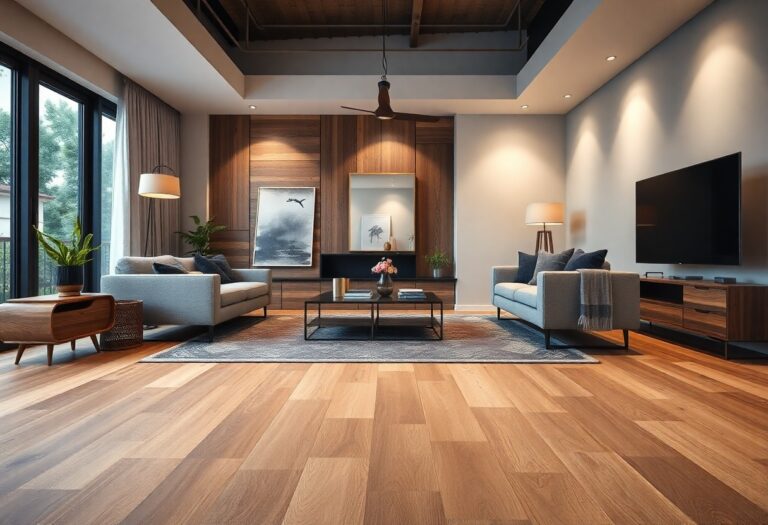Colors play a pivotal role in shaping the ambiance of your home, and selecting the right laminate flooring can greatly enhance the aesthetic of your space. You’ll want to consider factors such as the size of the room, natural light, and existing furniture to ensure your flooring complements your overall design vision. By understanding the variations in look and texture offered by laminate options, you can make an informed choice that not only beautifies your environment but also meets your practical needs. Dive in as we guide you through the process of picking the perfect laminate flooring.
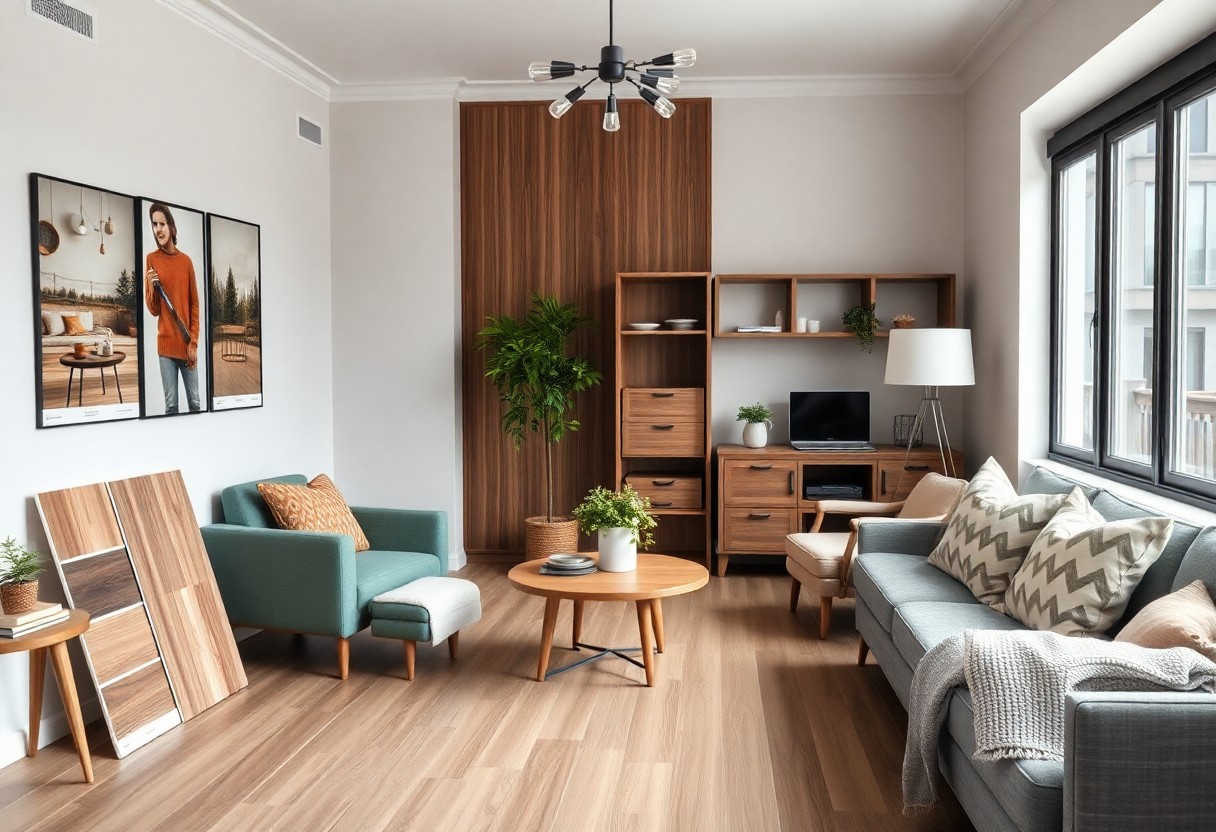
Key Takeaways:
- Consider the room’s purpose and natural light when selecting colors; lighter shades can make a space feel larger and more open, while darker tones provide warmth and coziness.
- Choose a style that complements your existing decor; for instance, traditional decor may benefit from classic wood looks, while modern spaces can be enhanced by sleek, minimalist designs.
- Think about maintenance and durability; some finishes can provide better scratch and stain resistance, especially for high-traffic areas.
Understanding Laminate Flooring
What is Laminate Flooring?
The term laminate flooring refers to a multi-layered synthetic flooring product that mimics the appearance of natural wood, stone, or other materials. This flooring type is constructed through an advanced photographic process that produces realistic designs and textures. Essentially, laminate consists of four main layers: a backing layer for stability, a core layer made of high-density fiberboard for strength, a decorative layer featuring a high-resolution print of your desired style, and a wear layer that provides durability and protection from scratches and stains. This innovative manufacturing process allows laminate flooring to capture the aesthetics of traditional materials without the associated high costs.
Understanding laminate flooring becomes necessary when considering it for your space. Due to its composition and structure, laminate is designed for durability and can withstand everyday wear and tear, making it an excellent choice for busy households. Additionally, its resistance to moisture and easy maintenance make laminate a preferable option for kitchens and bathrooms, where spills can be a concern. Choosing laminate flooring doesn’t mean sacrificing style—your options are virtually limitless, enabling you to find a look that beautifully complements your interior design.
To wrap things up, laminate flooring presents a functional, attractive alternative to natural materials. With various styles available—from rustic wood grains to chic stone appearances—you can enhance any space without the hefty price tag. By exploring the full spectrum of laminate offerings, you’re setting the foundation for stylish, practical living that meets your aesthetic and budgetary needs.
Benefits of Laminate Flooring
Some of the most notable benefits of laminate flooring include its affordability, ease of installation, and broad range of designs. Unlike traditional hardwood or stone flooring, laminate offers a cost-effective solution that fits within any budget while still achieving a high-end look. This budget-friendliness doesn’t diminish quality; laminate flooring is built to last, with various grades available depending on your heavy foot traffic or aesthetic preferences.
Another significant advantage of laminate flooring is its straightforward installation process. Many laminate floors employ a click-lock design that enables you to install them without the need for glue or nails. The DIY-friendly nature of laminate flooring allows you to take on your home renovation projects confidently. Furthermore, because laminate is relatively lightweight, transporting and handling it becomes less labor-intensive, making it accessible for nearly anyone looking to upgrade their space.
When discussing the advantages of laminate flooring, it’s important to highlight its durability as well. Many laminate varieties come with a wear layer that makes them resistant to scratches, stains, and fading. This means that you can enjoy the beauty of your floor for years without worrying about damage from everyday activities. Laminate flooring is also hypoallergenic, helping to maintain a cleaner environment, as its non-porous surface does not harbor dust and allergens like traditional carpet might.
Different Types of Laminate Flooring
On your journey to selecting the right laminate flooring, you will discover that there are several different types to choose from. These types typically fall into categories based on thickness, texture, and intended use. For instance, you may encounter options labeled as AC1, AC2, AC3, and so forth. Each AC rating indicates the floor’s durability—AC1 is ideal for low-traffic areas, while AC3 is better suited for moderate to high-traffic spaces. Understanding these ratings can help you make informed decisions about which type best suits your lifestyle and requirements.
| Type of Laminate | Description |
|---|---|
| AC1 | Designed for light residential use, suitable for bedrooms and casual spaces. |
| AC2 | Best for moderate residential settings, such as living rooms. |
| AC3 | Durable enough for high-traffic residential or light commercial use. |
| AC4 | Ideal for commercial settings or very busy residential areas, providing exceptional durability. |
| AC5 | Designed for heavy commercial use requiring outstanding resistance. |
Types of laminate flooring also include various textures, such as smooth, embossed, and hand-scraped finishes. These textures play a crucial role in how realistic the floor appears and how well it fits with your overall design scheme. What’s more, laminate flooring offers a wide color palette, from bright, modern hues to classic, earthy tones. Each choice you make can reflect your personality and create the atmosphere you desire in your home. Perceiving these distinctions will enable you to select the right type of laminate flooring that aligns with your style and practical needs.
To sum up, understanding laminate flooring entails knowing the different types available, their benefits, and the nuances in their construction. In this ever-evolving industry, staying informed helps you make choices that best suit your home environment and lifestyle.
- AC ratings
- Texture options
- Cost-effectiveness
- Installation ease
- Durability
This knowledge will allow you to navigate the laminate flooring landscape confidently and transform your space beautifully.
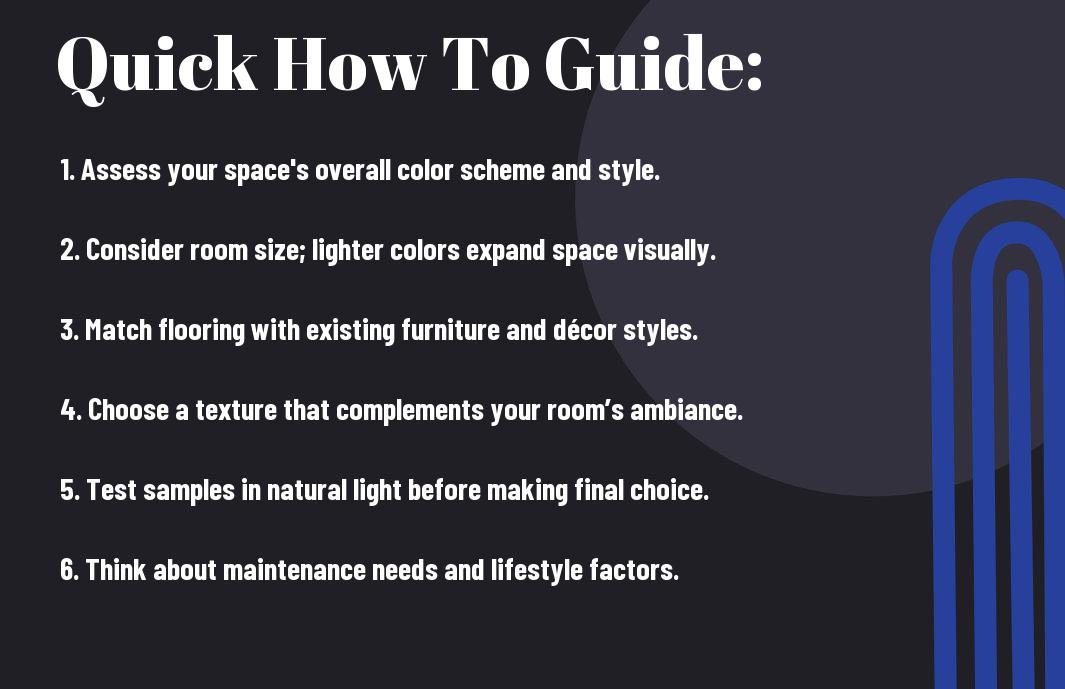
Factors to Consider When Choosing Laminate Flooring
If you’re venturing into the world of laminate flooring, it’s pivotal to consider various factors that will help you make an informed choice. Decisions about color and style can greatly influence the overall atmosphere of your space. Here are some key factors to guide you:
- Purpose of the Space
- Foot Traffic Levels
- Room Size and Layout
- Lighting Conditions
- Existing Color and Style
Purpose of the Space
Now, understanding the purpose of the space is fundamental when selecting laminate flooring. Different rooms serve distinct functions and thus demand specific flooring characteristics. For example, if you’re updating a busy family room, you’ll want a floor that is durable and can withstand wear and tear. Conversely, a flooring style chosen for a guest bedroom might prioritize aesthetics and comfort over sheer toughness.
While some spaces benefit from trendy and vibrant colors, others may call for more subdued, timeless hues. For a home office, you may prefer a laminate that promotes a calm and professional atmosphere, while a children’s playroom might be best suited to bright colors and fun patterns. Consider both the visual and functional aspects of your laminate selections so they enhance the room’s purpose.
Moreover, the purpose of the space often ties in closely with the activities that will take place there. If spills, scratches, or heavy furniture will be common, opting for a laminate that is resistant to these issues can save you time and money down the road. By identifying the primary use of your space, you can narrow down your choices to those that best meet your needs.
Foot Traffic Levels
There’s no denying that foot traffic levels play a significant role in determining the right laminate flooring for your home. Areas that receive high foot traffic, such as hallways or living rooms, will benefit from more durable options. Laminates are rated on a scale of AC1 to AC5, with AC5 being suitable for heavy commercial use, while AC1 is intended for light residential use. Selecting the right grade will not only maintain the aesthetics of your flooring but also enhance its lifespan.
In lower traffic areas, such as formal dining rooms or guest bedrooms, you may have the flexibility to choose less durable options that offer more variety in style or color without worrying as much about wear and tear. Here, you can explore textures, finishes, and designs that create a unique ambiance that suits your decor, offering you a chance to be more creative with your design choices.
Flooring also plays an important role in your home’s overall function and can influence the comfort level within different areas. Paying attention to foot traffic will guide you in choosing styles that align with practical needs while allowing you to create a stylish look that complements your home.
Room Size and Layout
Now, when considering your flooring options, the room size and layout can’t be overlooked. The dimensions of your room can affect your choice of laminate colors and patterns significantly. Larger spaces can accommodate more elaborate designs and darker colors, which can add a modern touch and visually enlarge open areas. Alternatively, smaller rooms may benefit from lighter colors and simpler patterns that can give the illusion of a more expansive space.
Additionally, the layout of your room can dictate how you select laminate flooring. For instance, a long hallway may call for boards that are aligned in such a way that they elongate the space, while a square room may look best with designs that contrast. Be mindful of how the layout interacts with your flooring choice to enhance the overall appearance of your space.
Factors such as room size and layout not only impact aesthetics but also functionality. Ensuring that your laminate flooring complements your room’s dimensions can lead to a harmonious environment that meets both your design aspirations and practical needs.
Lighting Conditions
Size and quality of lighting can drastically change the perception of color and detail within your chosen laminate flooring. Natural light enhances color vibrancy, while darker spaces may dull colors. If your space gets ample sunlight, you might want to opt for deeper shades that won’t become washed out or overly bright. Alternatively, in rooms that rely heavily on artificial light, lighter laminates can reflect light and make the area feel brighter and more inviting.
Understanding the lighting conditions will guide you in selecting a laminate option that complements the atmosphere you aim to create. For instance, warm lighting can add a cozy feel when matched with earthy or rich tones, while cooler, fluorescent light might require you to choose flooring that balances out those tones with softer hues or textures.
Layout relationships between furnishings also come into play when considering lighting. Adequate testing under various lighting scenarios will help you make informed decisions that harmonize with your space’s natural and artificial light sources.
Existing Color and Style
Style plays a vital role when it comes to harmonizing your new laminate flooring with the existing color and style in your home. A well-thought-out choice will create a cohesive and unified look that reflects your personality. Take into account the tones and textures of your walls, furniture, and other decorative elements. Consider whether you want your new flooring to blend in for a cohesive look or stand out to make a bold statement.
When you analyze the existing decor, you will discover opportunities to either enhance or contrast your laminate flooring with surrounding elements. For example, if your space is modern with minimalistic furniture, choosing sleek laminate designs can accentuate that style, while more rustic environments may call for warmer, textured laminate options that echo natural wood finishes.
When choosing laminate flooring, it’s best to also consider how your new flooring will mesh with the entire room. A well-matched floor can create visual interest and transition seamlessly between different spaces within your home for a polished and curated look.
How to Choose the Right Color
Despite the plethora of options available, selecting the perfect color for your laminate flooring can significantly impact the overall ambiance of your space. This decision involves various factors such as personal taste, lighting conditions, and existing decor. While browsing through samples, it’s imperative to consider the overall feel you want to achieve. Are you leaning towards a serene, calming atmosphere, or are you aiming for a vibrant, energetic space? An informed choice could lead you to a design that resonates with your vision.
Neutral vs. Bold Colors
One of the first decisions you’ll need to make is whether to opt for neutral or bold colors. Neutral tones, such as grays, beiges, and taupes, provide a versatile backdrop that can complement a wide range of furnishings and decor styles. These colors tend to create a calming and inviting atmosphere, making them ideal for spaces like living rooms and bedrooms where relaxation is imperative. Furthermore, neutral flooring can help future-proof your decor choices, allowing you to change your furnishings without needing to replace your floors.
On the other hand, bold colors, including deep blues, rich reds, or even shades of green, can make a striking statement. If you want your space to reflect your personality or create a distinctive look, bold flooring colors can add vibrancy and interest. They tend to work well in modern or eclectic designs, especially in areas like dining rooms or home offices where you might want to inspire creativity and energy. However, it’s important to consider how a bold color will play with the rest of your home’s palette, as it can easily overpower a room if not balanced correctly.
Ultimately, the choice between neutral and bold colors should align with your personal style and the function of the space. Consider how each color will work with given lighting, room usage, and nearby furnishings. A thoughtful examination of these factors will guide you in making an informed and satisfying choice for your flooring.
Color Palettes for Different Spaces
While each space in your home has its unique character, selecting a color palette appropriate for each area can enhance its purpose. For example, in a kitchen, light-colored laminate flooring can create an airy and spacious vibe, making the area feel larger and more inviting. In contrast, darker hues can add warmth and coziness, particularly in a family room or den, promoting relaxation and comfort. It’s also vital to consider the activities that will take place in these spaces when choosing your colors.
In bathrooms, a soft palette with light greens or blues can evoke a spa-like serenity ideal for unwinding. Meanwhile, rich colors in your home office can increase focus and productivity by creating a vibrant yet calming environment. By observing the natural light that enters each space and how it affects color perception throughout the day, you can gain valuable insight into the best color choices for achieving the desired atmosphere.
Color, therefore, should not only reflect your style but also cater to the function and mood you wish to create in each room. A well-planned color palette can unify different spaces, enhancing the overall aesthetic flow of your home.
Understanding Undertones
With each color, there are underlying undertones that can make or break your design choice. These undertones may include subtle hints of warmth or coolness that add depth to the color. For example, a beige floor could lean towards a yellow undertone, which may clash with cooler furniture designs, while a gray may have blue undertones that create a serene feeling. Understanding these subtleties is key to achieving harmony in your space.
As you choose laminate flooring, pay close attention to how different undertones interact with your existing decor. Often, you can use these undertones as a guide to select furniture, wall colors, and other decorative elements that will either complement or contrast the flooring effectively.
Matching with Furniture and Decor
Color coordination is vital to achieve a cohesive home design. Color schemes should blend harmoniously with your furniture and decor. For instance, if your living room features rich, warm wooden furniture, opting for flooring that shares similar undertones can create a seamless look. Alternatively, if your style leans towards modern minimalism with cool, sleek lines, a high-contrast flooring color can create a striking effect.
In addition to furniture, consider artwork and decorative elements in the space. If your room is decorated with vibrant artwork or colorful furniture pieces, you might want to choose a calmer, neutral hue for the flooring to serve as a foundation that allows your decor to shine. This balance helps prevent your room from feeling cluttered or overwhelming.
To achieve the best aesthetic outcome, focus on the color wheel and complementary colors. Use a mix of shades and tones to create depth, and don’t hesitate to include textures to elevate the overall design. Careful selection and matching ensure your laminate flooring enhances rather than clashes with your overall decor.
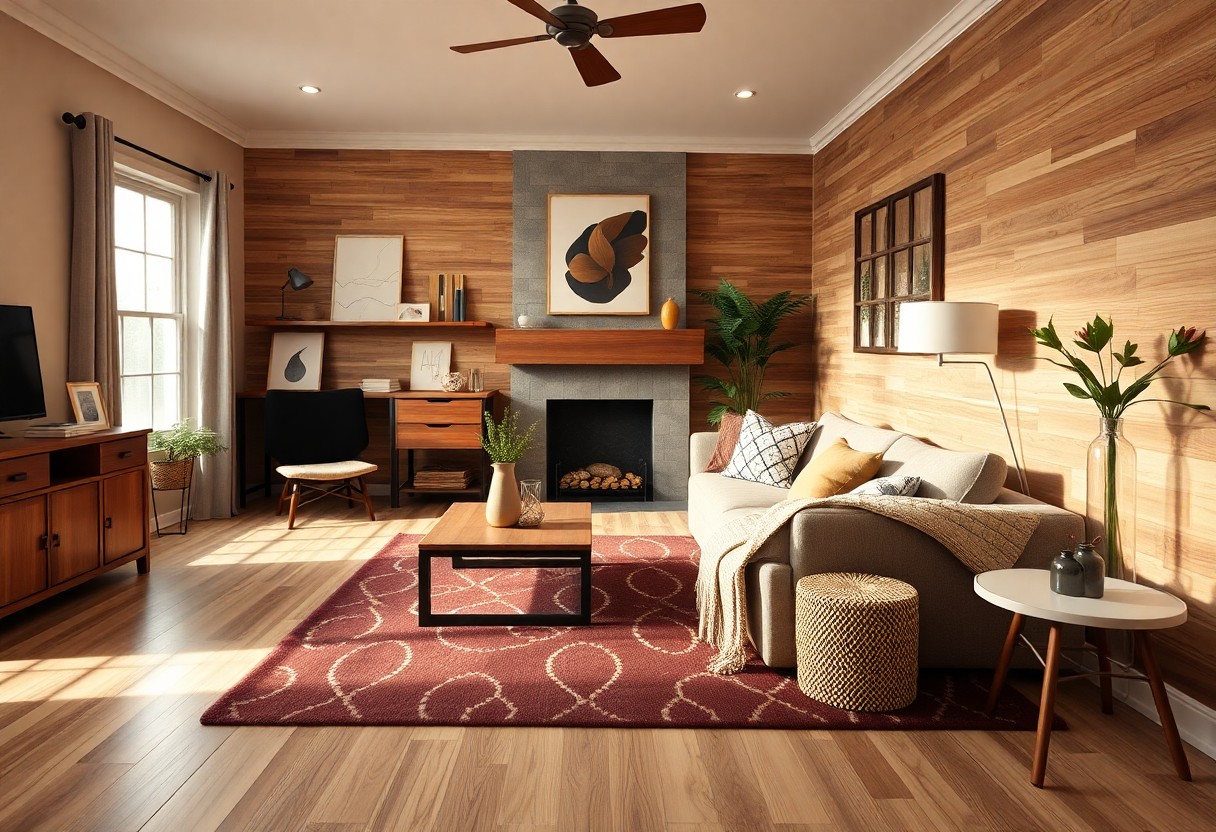
Styles of Laminate Flooring
For homeowners looking to elevate their living spaces with laminate flooring, understanding the various styles available is integral to making an informed choice. The aesthetic you choose sets the tone for your entire home, whether you’re aiming for a classic, timeless vibe or a modern, sleek look. By grasping the differences between traditional and contemporary styles in laminate flooring, you can appropriately match your flooring to your personal style and the overall theme of your home. Traditional styles often emphasize warmth and familiarity, featuring embossed wood grains, rich color palettes, and intricate patterns that evoke a sense of heritage. Conversely, contemporary styles present a more minimalist approach, with cleaner lines, neutral colors, and a focus on functionality that suits a modern lifestyle.
Assuming you lean towards a traditional aesthetic, you might consider laminate options that mimic the details found in natural hardwoods or classic tiles, giving your home a cozy and inviting atmosphere. These styles often prioritize a designed look that tells a story, and they complement vintage furniture or ornate décor beautifully. On the other hand, if contemporary is more your speed, you should explore laminate flooring that embodies simplicity and sophistication, perhaps opting for shades of gray or white that can make a space feel open and airy. Modern laminate choices may also include wider planks or unique designs that enhance the spatial dynamics of your rooms, aligning seamlessly with contemporary furnishing.
Ultimately, the best choice depends not only on your personal preference but also on the specific characteristics of your space. Be mindful of the existing elements in your home—your furniture, wall colors, and architectural details, as these will inform your decision. A well-chosen laminate flooring style harmonizes with its surroundings, effectively enhancing both the beauty and functionality of each room. By carefully weighing your options and understanding the distinctions between traditional and contemporary styles, you can confidently select the perfect laminate that reflects your unique taste.
Textured Finishes: Hand-Scraped vs. Smooth
Styles of laminate flooring are further refined by the finishes available, with textured options like hand-scraped finishes contrasting starkly with smooth surfaces. Hand-scraped laminate adds a rustic charm to your home with its uniquely crafted appearance, reflecting the artisanal touch of traditional wood flooring. This finish can bring depth and character to your rooms, as every plank has a different texture. It’s especially suited for homes that embrace a farmhouse or rustic theme, where it’s important to create an inviting atmosphere. On the other hand, smooth finishes yield a sleek, polished look that signifies modern luxury. If your style aligns with contemporary aesthetics, a smooth laminate will contribute to an environment that feels spacious and chic, effectively showcasing your furniture and décor without any distractions.
A textured finish, particularly hand-scraped, can also serve a functional purpose beyond aesthetics. This style effectively helps to mask dirt and scratches, making it a practical choice for busy households or spaces that experience high foot traffic. In contrast, while smooth finishes are easier to clean, they may require more maintenance to keep them looking pristine. It’s a balance between the ease of upkeep and the desired visual impact that you must consider when making your selection.
Additionally, your choice can affect the perceived warmth of your space. Hand-scraped finishes often evoke a more homey feel, while smooth textures can enhance a feeling of modern sophistication. Ultimately, the decision between hand-scraped and smooth finishes should resonate with the atmosphere you envision for your home, allowing you to create harmonious spaces that reflect your lifestyle.
Plank Size and Shape Variations
You have an array of choices when it comes to plank size and shape, and these options significantly influence the overall aesthetics of your flooring. Wider planks can create a spacious feel in rooms by reducing the number of seams and contributing to a more streamlined appearance. They also work wonderfully in larger areas, enhancing an open-plan layout’s functionality. Conversely, narrower planks can add texture and intricate detail, making them an excellent choice for smaller spaces or areas that require a touch of coziness. When you think about the shape, traditional rectangular planks go hand-in-hand with most interior styles, while unique shapes, such as herringbone or chevron patterns, can breathe new life into any room and make a statement about your distinct design preference.
Moreover, the proportion between the size of your planks and the dimensions of the room is vital. Oversized planks may overwhelm a smaller area if not chosen carefully, while narrower ones may chop up the visual flow in larger spaces. You want to ensure that your plank dimensions work cohesively with your room’s scale and layout. In this regard, opting for uniformity in plank size can create a more synchronized atmosphere, while a mix of styles and shapes can introduce a fun, personalized flair. These choices reflect your personality and how you want to interact with your space.
Plus, understanding the variety of plank sizes and shapes also coincides with functional decisions. For instance, if your home experiences a lot of movement, wider planks often have a stronger structural integrity and performance. On the other hand, if you are leaning towards a versatile aesthetic, you may want to explore mixes of sizes for specific zones within your home, enhancing functionality while showcasing your tasteful eye for design.
Popular Patterns and Designs
Now that you are familiar with styles, finishes, and dimensions, exploring popular patterns and designs can add that extra layer of personalization to your laminate flooring. Patterns such as herringbone or staggered layouts can create visual interest while guiding the eye throughout the room. Popular designs often vary from realistic wood grains to tile and stone imitations, allowing you to choose an option that best resonates with your home’s style. A key advantage of laminate flooring lies in its ability to mimic high-end materials without the associated costs, giving you access to sophisticated aesthetics while maintaining budget-friendliness.
When selecting your design, consider how it interacts with the other elements in your home. Patterns that are too bold may dominate the space, overwhelming your furnishings or display pieces, while more subtle designs maintain equilibrium with your décor. Customizing your floors with unique patterns can inject your individual style into the space, and it can act as a focal point in your room, augmenting the overall ambiance.
Contemporary designs might lean towards minimalistic and geometric patterns that evoke a sense of clarity and organization, while traditional styles might feature floral or ornate designs that add warmth and richness. Ultimately, the choices you make for patterns and designs should create a lasting impact in your home, allowing you to enjoy a remarkable blend of beauty and functionality in your laminate flooring.
Tips for Selecting the Perfect Laminate Flooring
Once again, choosing the right laminate flooring can be overwhelming with the myriad of options available. To help you make a decision that you’ll be happy with for years to come, consider the following tips:
- Define your space and its function
- Select a texture and finish that complements your interior
- Think about the color palette of the room
- Choose a style that fits your personal taste
- Test samples in natural light before making a final decision
Any one of these factors can significantly impact how laminate flooring looks and feels in your space. Make sure to take your time and evaluate each aspect carefully.
Sample Testing in Your Space
Laminate flooring is available in numerous styles and colors, so it’s crucial to assess how a specific choice will look in your home before committing. This is where sample testing comes into play. By obtaining samples of the laminate flooring you’re considering, you can bring them home and observe how they interact with your existing decor, lighting, and furniture. Observing the samples in different lighting conditions, such as natural daylight versus artificial light, will give you a clearer picture of how the flooring will appear throughout the day.
Also, laying out the samples in the actual area where you intend to install them can provide valuable insights. You will get a sense of the scale, color harmony, and texture in the context of your room. It helps you visualize how the flooring will fill the space and whether it complements or detracts from your design scheme. Keep in mind how busy your lifestyle is, as the right choice can aid in creating a more cohesive look while also aligning with your everyday needs.
Additionally, while you evaluate the samples, think about the practicality of different textures. High-gloss laminates may be a stunning focal point but can also highlight scratches and dirt. On the other hand, textured finishes can be forgiving and add depth but may also require more maintenance. Your choices should reflect not only your aesthetic preferences but also your day-to-day activities. This way, you can ensure that the laminate flooring you choose will hold up stylishly over time.
Considering Maintenance and Durability
Little do many homeowners realize that the maintenance and durability of laminate flooring play an crucial role in their long-term satisfaction with their choice. Laminate flooring is often appreciated for its resilience, primarily because it can withstand heavy foot traffic and is resistant to staining. However, it’s vital to consider the wear layer of the laminate, which determines its strength against scratching, denting, and fading. The thicker the wear layer, the more durable your flooring will be, making it a perfect choice for busy households.
Additionally, the ease of maintenance is another factor worth noting. Unlike hardwood floors that require refinishing, laminate flooring typically only needs regular sweeping, vacuuming, and occasional mopping with a recommended cleaner to keep it looking pristine. However, keep in mind that while laminate is waterproof, it can still be susceptible to moisture damage if spills are left unaddressed. Thus, being proactive about spills will enhance your laminate’s longevity.
Considering your lifestyle before making a decision is also vital. If you have pets or children, opting for a laminate with a higher durability rating will ensure that it withstands wear and tear over time. While laminate can mimic the appearance of more expensive materials, always consider how this choice aligns with your living situation to make informed decisions. The right laminate floor can serve your household well for years to come.
Consulting with Professionals
Sample testing can provide you with personal experience with the product, but consulting with professionals brings expertise to the table. Professional flooring specialists can guide you toward the best options for your specific needs and preferences. They not only have immense product knowledge but can also lend insights into installation practices and help you identify any potential challenges during the process.
When working with a professional, they can also assist you in evaluating the flooring against factors like moisture levels, subfloor compatibility, and even budget constraints. This level of expertise ensures that you avoid costly mistakes that could arise from incompatible flooring choices or poor installation techniques. They may also recommend specific brands or styles that might otherwise go unnoticed but could be perfect for your space.
Space planning is another aspect where professional advice can truly make a difference. They can help you visualize the finished product through drawings or computerized models, ensuring that the laminate you choose harmonizes with your overall design goals. Seeking their assistance can be invaluable in making a well-rounded decision.
Staying Within Your Budget
Little is often said about the importance of budgeting at the outset of any home renovation project, including selecting laminate flooring. Before exploring your options, it’s wise to set a realistic budget based on your particular circumstances. Laminate flooring can vary substantially in price based on factors like thickness, brand, and design, so determining your budget early on will help guide your choices.
Additionally, don’t overlook the costs associated with installation. Some homeowners may be tempted to save money by attempting a DIY installation; however, this can lead to expensive errors. Weigh the benefits of hiring professionals against the potential pitfalls of DIY, and factor this into your budget. Ensuring that you have included all possible expenses allows for a more accurate understanding of what you can afford.
With proper planning, staying within your budget does not mean sacrificing quality or style. By researching various products and installation methods, you’ll be better equipped to make informed decisions that will positively impact both your wallet and the final look of your laminate flooring.
Installation Considerations
All homeowners who have decided to install laminate flooring understand that installation is a significant aspect of the process. Your approach could greatly influence not only the aesthetic appeal of your space but also the longevity and performance of the flooring. This chapter will examine into important considerations you need to keep in mind for a successful installation, including whether to opt for DIY installation or hire a professional, the importance of subfloor preparation, and the acclimation period for laminate. Each of these aspects will contribute to a smooth and seamless flooring experience.
DIY vs. Professional Installation
One option you will face when considering installation is whether to take on the project yourself or hire a professional. If you’re handy and enjoy home improvement projects, going the DIY route can be both satisfying and educational. However, it’s important to assess your skills and experience with flooring installation. While laminate flooring is often marketed as a “do-it-yourself” option, complications can arise if you encounter uneven subfloors, complicated layouts, or intricate cuts. Consider reading some installation guides or watching tutorial videos before making your decision.
On the other hand, hiring a professional may provide you with the assurance of a job well done. Professionals bring years of experience and expertise to the table. They can quickly identify and resolve any issues that may come up during installation, ensuring that your flooring is laid down correctly and will perform as intended. Moreover, working with experts can often come with warranties and guarantees that provide peace of mind regarding the quality of the work.
Ultimately, your choice will depend on your personal comfort level and budget. Weighing the pros and cons of each option can guide you to select the best path for your installation project. If you decide to go with a professional, be sure to seek out recommendations, check references, and ensure you’re working with accredited contractors. This can prevent you from falling victim to poor workmanship.
Subfloor Preparation
For a successful laminate flooring installation, subfloor preparation is a task that absolutely must be addressed. Without a solid and even foundation, your laminate flooring may face issues down the line, such as warping, squeaking, or even damage. It is vital to inspect your existing subfloor for any irregularities. If you’re working with concrete, ensure it has been adequately cured and is free from moisture. Recommendations typically suggest that any dips, cracks, or damaged areas be repaired before laying down your laminate.
Additionally, you will want to make sure your subfloor is clean and dry. Sweeping and vacuuming debris will help to create the ideal surface for installation. Measuring the moisture content of the subfloor can also prove valuable, as excess moisture can compromise the integrity of your laminate flooring. Applying an underlayment is another preparatory step that can further enhance sound absorption and moisture protection, especially if your subfloor is concrete or another problematic surface.
This preparation phase is not just basic maintenance; it serves to align the foundation of your laminate floor with the manufacturer’s specifications. Taking your time to get this right may save you significant headaches in the future. Avoid rushing through this step, as subfloor preparation is integral to the overall success of your flooring investment.
Acclimation Period for Laminate
On the journey to a successful laminate flooring installation, one often overlooked key factor is the acclimation period for laminate. Before installation, it’s important to allow your laminate flooring to adjust to the room’s temperature and humidity levels. Failure to do so can lead to issues such as expansion or contraction after the flooring has been installed, which can significantly detract from the visual appeal of your space. Ideally, you should keep the laminate planks in the room where they will be installed for at least 48 to 72 hours.
During the acclimation period, it is wise to maintain a consistent climate in the room. This means avoiding sudden temperature changes that could cause the planks to swell or shrink. To achieve optimal results, keep the room at a temperature between 60°F and 80°F and a Relative Humidity (RH) between 30% and 50%. These conditions will help the material stabilize and adapt to your home environment.
Installation can be a delicate process, so ensuring that your flooring has properly acclimated to the environment pays off in the long run. A commitment to this step can enhance not only the durability of the installation but also the overall comfort and performance of your laminate flooring.
Maintenance Tips for Longevity
Keep your laminate flooring looking fresh and vibrant by following some straightforward maintenance tips. Proper care can significantly extend its life and preserve its aesthetic appeal. Here are some fundamental measures you can take:
- Wipe up spills immediately to prevent water damage.
- Use a vacuum or broom designed for hard surfaces regularly.
- Place mats at entrances to trap dirt and debris.
- Avoid heavy furniture dragging by using pads beneath legs.
- Consider using a humidifier in dry conditions to maintain optimal moisture levels.
This will not only maintain the beauty of your laminate flooring, but also ensure that it remains durable for years to come.
Cleaning Techniques
Longevity of your laminate flooring largely depends on the cleaning techniques you employ. Use a soft microfiber mop, as it effectively removes dust and dirt without scratching the surface. For deeper cleaning, opt for a cleaning solution specifically designed for laminate flooring. Typically, a mixture of warm water and a few drops of dish soap can work wonders, but be cautious not to saturate the planks. Applying too much moisture can lead to swelling and warping, undermining the integrity of your flooring.
When tackling stubborn stains, it’s wise to test any cleaner in an inconspicuous area first. If all goes well, you can apply it to the stain by gently scrubbing with a soft cloth. Avoid abrasive cleaners and tools, as these can scratch and dull the surface of your laminate flooring. Instead, focus on gentle methods paired with the right cleaning agents to restore your flooring’s shine without causing damage.
Lastly, be proactive about maintaining your flooring. Establish a routine cleaning schedule to regularly address dirt buildup. By consistently cleaning, you can minimize the risk of build-up that can lead to tougher cleaning jobs down the line. This discipline in cleaning will ensure that your laminate flooring stays in optimal condition.
Avoiding Common Damage
Clearly, taking preventive measures to avoid damage to your laminate flooring is vital. One of the main risks to laminate flooring is moisture, which can seep between the boards and cause swelling. To mitigate this risk, ensure that you vacuum or sweep regularly to prevent dirt and grit from becoming abrasive. Any spills should be wiped up immediately with a soft, dry cloth. Avoid steam cleaning as it can lead to water seepage; instead, opt for products specifically marketed for laminate.
Ensure your cleaning products are compatible with your laminate flooring, as certain chemicals can discolor or warp the material. Additionally, place protective mats in areas where water may accumulate, like kitchens and bathrooms, to further shield your flooring from moisture. It’s also wise to avoid walking on your flooring with high heels or cleats, as they can create dents and scratches that mar its appearance.
Your efforts in avoiding common damage will definitely pay off in preserving the quality of your laminate flooring. Keeping items that could tip or fall away from the edges can also prevent unintentional harm, such as chips and dents. Taking these small but vital steps can significantly contribute to the durability of your flooring.
Regular Maintenance Routines
On a routine basis, perform maintenance actions that enhance the lifespan of your laminate flooring. Establishing a schedule to clean and assess your flooring will ensure that it remains in excellent condition. Regular checks for wear and tear can help you catch potential issues early on, allowing you to address them before they become significant. You might want to incorporate a weekly vacuum or sweeping session into your routine to eliminate debris.
A monthly deep clean can also provide your laminate flooring with a fresh start. This entails a more thorough cleaning using a microfiber mop alongside appropriate cleaning solutions. Be sure to follow up with a dry mop afterward to eliminate any moisture left behind. Furthermore, consider implementing seasonal checks where you inspect the floor for scratches or signs of damage, and apply touch-up solutions as needed. This proactive approach toward maintenance will aid in preserving the beauty and functionality of your flooring.
Tips for keeping your laminate flooring looking exceptional include setting reminders for your cleaning schedule and investing in quality cleaning tools designed specifically for laminate surfaces. Be mindful of the environment where your flooring is laid, as climate changes can also affect its performance. Following through with these regular maintenance routines will undoubtedly enhance the longevity of your beautiful laminate floors.
Final Words
On the whole, selecting the perfect color and style of laminate flooring for your space is a blend of personal taste and practical considerations. You need to envision how the flooring will harmonize with your existing decor while also contemplating functional elements such as durability and maintenance. Before submerging into your selection, take some time to assess the size, lighting, and overall theme of the room where the flooring will be installed. Dark colors can create a cozy atmosphere but might make a smaller room feel even tighter, while lighter shades tend to open up a space and provide an airy feel. Ultimately, the choice you make should reflect both your aesthetic preferences and the practical needs of your living area.
In addition to color, style plays a pivotal role in enhancing the beauty and functionality of your floors. There are countless finishes and textures available, from wood-look laminates that add a rustic charm to sleek, modern options that create a contemporary vibe. You should think about how these styles complement your furniture and wall colors, ensuring that everything ties together seamlessly. Don’t hesitate to obtain samples of various styles and colors so you can see how they interact with your room’s light and furnishings throughout the day. This hands-on approach will empower you to make an informed decision that aligns with your vision for the space.
Finally, it’s wise to keep an eye on trends and innovations in laminate flooring while also trusting your instincts. While it can be beneficial to understand what’s fashionable in the moment, your home should ultimately be a reflection of you and your personality. Whether you choose vibrant hues, muted tones, or classic designs, focus on what resonates with you personally. By combining your unique style with thoughtful consideration of practical aspects, you can confidently select the laminate flooring that not only enhances your space but also enriches your life within it.


